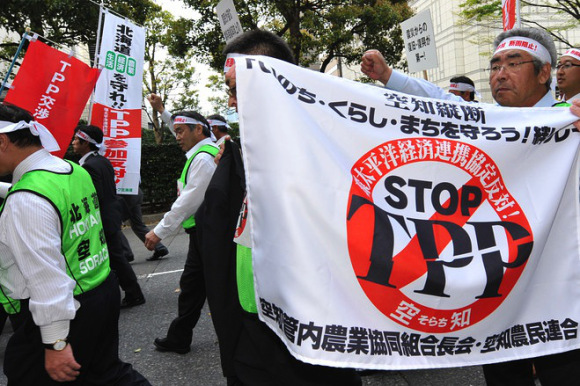TPP mitigation must be effective

The Japan Times | 30 November 2015
TPP mitigation must be effective
As his administration unveiled an outline of measures last week to help domestic industries cope with the effects of the Trans-Pacific Partnership trade pact, Prime Minister Shinzo Abe said the government will endeavor to make the economy stronger through the best possible use of the TPP, which will encompass markets of 12 countries with a combined population of 800 million, representing nearly 40 percent of the global economy. While the outline includes steps to help small and medium-size firms expand their overseas business, it is apparently aimed at quelling opposition and concern in agricultural sectors that will be affected most by the free trade regime, with an eye toward thwarting a revolt of agricultural votes against the ruling coalition in next summer’s Upper House election.
Since the outline was compiled in less than two months after broad agreement on the trade pact was reached in early October, it is uncertain whether the steps featured in the package will produce desirable results, even though they come at additional taxpayer costs. The effectiveness of the steps need to be continually monitored and scrutinized, and the government should be ready to amend or scrap measures whose effects prove to be dubious or detrimental.
Once the TPP is ratified by the participating countries and takes effect, import tariffs on about half of all agricultural and fisheries products will immediately become zero. Over time, the tariffs on 80 percent of those products will be eliminated. The outline contains fairly concrete steps to support domestic producers likely to face stiff competition amid the increased imports and possibly suffer income losses. The steps include government purchases of the same amount of rice from domestic farmers as Japan will be obliged to import under the TPP deal, and raising the rate for covering the losses incurred by beef and pork producers from the current 80 percent to 90 percent.
In explaining the TPP’s impact on domestic producers, the administration selected 61 types of agricultural and fisheries products and said the effects of the trade deal on them would be limited — an assessment reportedly questioned by some experts as premature. When Japan joined the TPP talks, the government promised to seek exceptional treatment for five “sanctuary” farm trade areas — rice, pork and beef, wheat, dairy products and foodstuffs used in the production of sugar. Since details of the TPP talks were wrapped in secrecy, whether the government kept that pledge has yet to be determined. The Diet needs to take up this issue as quickly as possible.
The outline says Japan’s farm and fisheries sectors need to be “on the offensive” and calls for moving up the schedule of achieving the government’s target of boosting food exports to ¥1 trillion by 2020. But the steps in the outline for making the sectors more competitive are abstract, such as nurturing and supporting farmers who have business and management capabilities through increased financial support and promotion of large-scale farming, and supporting the leasing of fishing boats to establish more sustainable and profitable fishing operations.
The biggest problem confronting Japan’s agriculture is the aging of and decline in the number of farmers. According to the latest census, the number of workers in the farming industry fell 516,000 from five years ago to 2.09 million, a decline of roughly 60 percent over the past three decades, with their average age reaching 66.3. The government needs to work out measures to attract young people to agriculture.
The Abe administration plans to include more than ¥300 billion in the extra budget for the current fiscal year to finance some of the outline’s policy steps. A major part of the funds are expected to be spent on public works project such as consolidating agricultural plots for large-scale farming and construction of new farm roads and water channels. The government must not repeat the same mistake it committed in carrying out steps to protect the agricultural sector from the effects of the 1993 Uruguay Round free trade agreement. The roughly ¥6 trillion spent at that time is widely believed to have had little effect on making the farm sector more competitive.
The government and the ruling coalition reportedly plan to compile a set of strategies by next fall to turn agriculture in Japan into a growth sector. It needs to be scrutinized whether pork-barrel spending will find its way into such measures. Wasteful spending in the guise of beefing up the farm sector is unacceptable, particularly in view of the nation’s fiscal woes, as exemplified by the public debt topping ¥1 quadrillion. What’s worrying in this respect is that an LDP policy document, on which the government’s outline was based, calls for securing “stable financial resources” to pay for the new TPP-related spending without specifying cuts or restraint on existing programs.
In the outline, the government says the TPP pact will not threaten food safety or the public health insurance system. It also pledges to strengthen the nation’s ability to handle conflicts with other governments and foreign businesses, including cases to be subject to the investor-state dispute settlement mechanism under the TPP. Since people have only scant information about these matters, the government needs to first explain in detail the TPP’s provisions on these issues.





